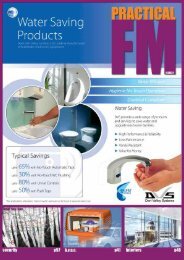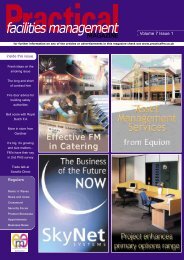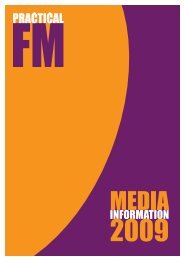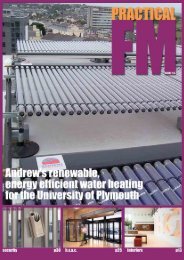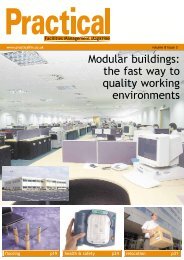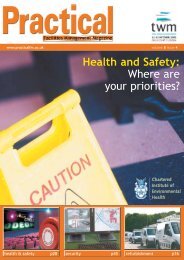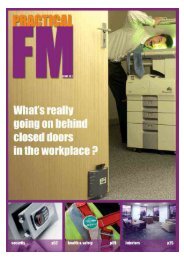Apollo Fire Detectors protect Leadenhall Market Apollo Fire ...
Apollo Fire Detectors protect Leadenhall Market Apollo Fire ...
Apollo Fire Detectors protect Leadenhall Market Apollo Fire ...
Create successful ePaper yourself
Turn your PDF publications into a flip-book with our unique Google optimized e-Paper software.
t-mac second<br />
generation BMS<br />
On the eve of new legislation being introduced<br />
in the UK governing energy consumption<br />
and efficiencies in buildings, Alan<br />
Wilkinson, Managing Director of t-mac<br />
Technologies and FAW Electronics, one of the<br />
UK’s leading designers and manufacturers of<br />
customised electronic control solutions, voices<br />
his thoughts on the increasing importance<br />
of IT facilitated building control systems in<br />
meeting legislative requirements.<br />
With the impending implementation of the<br />
Energy Performance of Buildings Directive and<br />
the changes to Part L of the Building<br />
Regulations, due to come into force from next<br />
year, the need for facilities managers to provide<br />
tangible proof that buildings under their control<br />
are both energy efficient and managed responsibly<br />
is now firmly on the agenda. Flexible and<br />
interactive building control systems are becoming<br />
increasingly important to delivering optimum<br />
efficiency.<br />
t-mac is one of the new generation of internet<br />
facilitated remote monitoring systems to enter<br />
the market. This discreet ‘second generation’<br />
building management system can remotely monitor,<br />
record and provide critical readings and<br />
historic reports on conditions imperative to the<br />
new regulations, such as heating, cooling, lighting<br />
and associated wastage levels.<br />
Listed on the Carbon Trust’s Energy Technology<br />
List, it is one of the few approved solutions<br />
which meets this building management legislation.<br />
The t-mac device is easily integrated<br />
within or installed close to the HVAC&R equipment,<br />
or independently installed within the<br />
building.<br />
The unit continuously collects data on the<br />
equipment or building via analogue and/or digital<br />
inputs. This data is then automatically<br />
transmitted wirelessly over the Internet by<br />
General Packet Radio Service (GPRS) (or alternatively<br />
via Ethernet or telephone line) at regular<br />
intervals off site, to a central server for<br />
remote viewing and analysis via any Internet<br />
enabled PC.<br />
While data logging is not a new concept, it is tmac’s<br />
ability to allow users to remotely data<br />
log, monitor and control information and gain<br />
access to analyse this data via any Internet<br />
enabled PC anywhere, and at any time, that is<br />
way ahead of other BMS devices. t-mac does not<br />
require dedicated PC/maintenance stations and<br />
associated software. Users log-on from their<br />
PCs through a unique and secure access control<br />
portal (username and password) to view live and<br />
historic data relating to conditions and status of<br />
individual or multiple pieces of equipment,<br />
departments or entire property sites worldwide.<br />
Should the pre-set levels of equipment operation<br />
fluctuate outside the desired limits, which<br />
are imperative for condition critical zones, tmac<br />
acts as an early warning system, sending<br />
accurate, detailed information about the<br />
change and requesting remedial action be<br />
taken. These alert notifications are sent via SMS<br />
and/or email to any number of pre-identified<br />
recipients as soon as a fault occurs, enabling<br />
decision-makers to respond promptly, on many<br />
occasions even in advance of a hazard or equipment<br />
failure occurring. Users can remotely<br />
change any of the programmed settings on the<br />
unit via a secure web page; these are then<br />
downloaded to the device.<br />
For remote control requirements, t-mac can be<br />
pre-set to automatically turn on air conditioning<br />
systems or remotely shut-down machinery<br />
should temperature levels become critical for<br />
example. Via the web page users can also carry<br />
out remote diagnostics on the equipment,<br />
department or site and request, through t-mac,<br />
to trigger a control application.<br />
Some media sources are lauding web based BMS<br />
as the next generation BMS. In my opinion there<br />
are many disadvantages to a web based system,<br />
mainly due to its connections through established<br />
Ethernet links and the requirement for<br />
users to log into the device via a dedicated IP<br />
address. There is no requirement for t-mac to<br />
be linked into a building’s existing IT system as<br />
it communicates via wireless GPRS links - it is<br />
entirely stand-alone, therefore if a building’s IT<br />
systems fail, t-mac won’t - plus there is no additional<br />
network ‘traffic’ potentially slowing<br />
down internal IT systems.<br />
Part L of the Building Regulations requires that<br />
a log of building services, plant and controls is<br />
kept to highlight assets, methods of operation<br />
and maintenance and any other additional<br />
details that enable energy consumption to be<br />
monitored and controlled. t-mac can account<br />
for energy consumption of equipment through<br />
the following techniques:<br />
log meter and sub-meter total gas, electricity<br />
and oil consumed within the building<br />
measure heating or cooling energy supplied to<br />
the building<br />
measure the run-hours of equipment that operate<br />
at a constant load<br />
measure the load of equipment<br />
allow users to estimate energy consumption<br />
from metered water for hot water supply<br />
monitor run efficiency of the water heater<br />
estimate non-constant small power loads<br />
From monitoring and measuring the above con-<br />
IT & communications<br />
Alan Wilkinson,<br />
Managing Director<br />
t-mac Technologies<br />
ditions, t-mac can create necessary reports for<br />
the log book to prove that assets and buildings<br />
are being run in an energy efficient manner.<br />
Part L2 of the regulations is aimed at improving<br />
efficiencies of installed services (HVAC&R, etc)<br />
and their operations to reduce energy consumption.<br />
t-mac can assist with analysis and production<br />
of valuable management information relating<br />
to equipment conditions, associated<br />
wastages, energy and asset inefficiencies and<br />
costs. The system can determine and measure<br />
where and how much energy is being used over<br />
a specific period and compare it to annual targets.<br />
Facilities managers can log on through their<br />
dedicated web page to view this asset information<br />
via interactive graphs, tables and gauges,<br />
which can easily be downloaded into CSV format<br />
for standard database analysis and reporting.<br />
t-mac achieves all of this without additional<br />
costly software, via any Internet enabled PC and<br />
without the requirement for human interaction.<br />
This type of report analysis allows adjustments<br />
to be made to increase efficiencies and, once<br />
made, further tracking reports can be produced<br />
to see how great the level of energy efficiency<br />
improvements are and how much has been<br />
saved over a designated period.<br />
The legislation on meeting building performance<br />
criteria will be enforced no later than April<br />
2006. Meeting new legislation should not be<br />
seen as a difficult or costly process. A t-mac system<br />
can be installed and up and running in a<br />
matter of minutes for under £2,000. Not only<br />
does t-mac’s advanced remote monitoring capabilities<br />
ensure equipment and sites are controlled<br />
and managed 24/7, there is an immediate<br />
return on investment achieved through the<br />
reduction in requirement for service engineers<br />
to undertake site visits to monitor critical conditions<br />
first-hand or employees hired to manually<br />
monitor site-based monitoring systems from a<br />
centralised location/call centre on a 24-hour<br />
basis. In addition, t-mac provides accurate data<br />
for facilities managers’ analysis and reporting<br />
requirements. Through its alerts and 24/7 data<br />
logging facility, t-mac highlights and records<br />
equipment or site inefficiencies allowing facilities<br />
managers to calculate and plan valuable<br />
cost-saving or energy management activities<br />
based on actual evidence.<br />
The t-mac system is listed on the Carbon Trust’s<br />
Energy Technology List for Automatic Monitoring<br />
and Targeting. Companies installing a t-mac system<br />
benefit from 100% capital allowance on<br />
their first year of expenditure.<br />
Reader Reply No.: 85099<br />
www.practicalfm.co.uk 35



